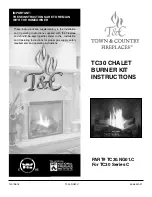
I
NSTALLATION
&
U
SERS
M
ANUAL
FIREPLACE
| SOL 60/70/80/90
16 |
Page
Wood combustion rules
If you want less heat, put a smaller quantity of wood in the fireplace and reduce the amount of air. It is however important to maintain
an adequate layer of cinder.
Less heat = Less wood = Less air.
More heat = More wood = More air.
When the fireplace operates at excessively low power or if the wood is not sufficiently dry, soot might deposit on the glass.
9.
T
ERTIARY
C
OMBUSTION
(P
ATENTED
)
The three combustion points
The combustion of wood requires a process of primary, secondary, and tertiary combustion to be efficient.
1.
Primary combustion
Primary combustion is the initial wood burning at relatively low temperatures. During the primary combustion, large amounts of soot, creosote
and gas are produced due to the existence of water in the wood. Creosote, in primary combustion, contains 60% of the potential energy of
wood, but it is deposited in the form of soot inside the fireplace and the flue without imparting any heating.
2.
Secondary combustion
The combustion chamber is insulated so as to increase the temperature of the core and by providing just the right amount of oxygen
necessary to 600
O
C, the creosote ignites spontaneously. This creates a chain reaction that increases the temperature inside the fireplace from
600
O
C to about 870
O
C without having to add any more fuel. This is the secondary combustion.
Thereby, the more proper secondary combustion is achieved the higher temperatures are produced and the less residue is left (gas and
particles). The vast majority of secondary combustion is only done in the upper part of the chamber near the outlet of the flue. Thus a large
part of the heat that is achieved, is discharged directly through the draft of the flue to the exterior and not in the heating area.
ARTE’s® patented chamber manages to provide the maximum secondary combustion performance. An
automatic air intake regulating system in cooperation with four or five vertical ducts and the combustion
space having openings, in such a way as to insert the appropriate amount of hot air through the entire
length of the pipeline, onto the calcined side of the combustion space and the aircurtains of the
ceramic glass
(Pic. 9.1.1)
, results in the fire receiving the right
amount of preheated oxygen throughout the combustion
chamber
(Pic. 9.1.2)
. This way the whole area of the chamber is
converted in a secondary combustion chamber, not only the
upper part, and thus its performance dramatically increasies
and inversely gas residue reduces.
3.
Tertiary combustion
The tertiary combustion occurs when the coal that remains on
the bottom burns in a proper and coordinated way. Coal
contains a large amount thermal energy that when used
provides a large amount of heat. Proper air flow directly on the
coals within such a hot room, results in almost complete consumption and minimizing the amount of ash
that collects on the bottom.
The fire should be vigorous and the smoke exiting from the flue must be almost
unnoticeable.
The fire should not be smoldering because it is causing more pollution.
If the door remains slightly open, fire gases and flames may escape from the opening of
the fireplace causing a risk of fire or asphyxiation. We recommend installing a smoke
detector in the room where the fireplace is located.
Under no circumstance should you operate the fireplace with the main door open. You
run a serious risk of destroying the device.
DO NOT OVERHEAT THE FIREPLACE! There is risk of fire or permanent damage. If any part
of the fireplace starts glowing, then the device is overheating.
Pic. 9.1.1
Pic. 9.1.2
Summary of Contents for SOL 60
Page 1: ......
Page 25: ...INSTALLATION USERS MANUAL FIREPLACE SOL 60 70 80 90 24 Page NOTES S N...
Page 26: ......










































